Yes, I finally got around to doing another interview. I’m just lazy ok. Plus I’ve been in a rut lately and I don’t think forcing an interview is the best way to treat my guests. That’s my excuse and I’m sticking to it. This one took way too long to finish up, sorry Blake!
Anyway, Blake Andrews is a photographer based in Oregon, USA. He’s a quite prolific in terms of how much he shoots, he does it all on black and white film, his style is very eclectic and he’s been photographing the same patch for a very long time. I was particularly interested to talk to him because of the seemingly endless series of ruts I’ve been going through lately, and I don’t think I’ve interviewed anyone yet that has been shooting for upwards of 20 years. I thought it’d be good to get his thoughts on how he treats the inspiration/rut cycle that a lot of us seem to suffer from. We also discussed the future of In-Public after two members left because they deemed a photo of Blake’s to be inconsistent with their personal definition of street photography.

© Blake Andrews
Hi Blake, I’ve been following your work for a while now. Mainly through your awesome blog, but also on instagram, and I have often wondered how you got your weird and wonderful username of @swerdnaekalb, and I only just realised that it’s your name backwards.
It’s obtuse and obvious at once. The same way some photos work.
Well it clearly wasn’t that obvious to me! I’m kicking myself now. I was never any good at word games! For those readers who don’t know who you are, can you just take a minute to introduce yourself?
I’m a photographer based in Eugene, Oregon. I shoot a variety of subjects and styles, but a primary theme running through all my photos is an exploration of how photos work, and how reality relates to its visual representation. In other words, I’m generally less concerned with subject matter than with how it translates photographically, and the questions that translation might generate. I find staged and studio photography generally uninteresting to shoot. Instead, I walk around with a camera and look at things, and try to react visually to what I see. I’ve made this a roughly daily practice for the past 25 years.
I first got into photography in my early 20s (I’m 49 now). I took an intro course, which back then meant learning 35mm monochrome film techniques and darkroom skills. After that I was off and running. I started making photographs of my daily world, slowly at first, but then with more regularity. Most of the photos I made then were of people and places in my immediate vicinity, and that’s continued to the present. This includes my family, friends, and any structures within sight. I have a poor imagination, so I can’t invent images from scratch. Instead I rely on my surroundings to feed me material, the world is my studio, and it has never failed me yet. Instead of searching out photos I usually have to fend them off. Because it turns out that once you start looking they’re fucking everywhere.
My home city of Eugene is a college town. The nearest largeish city is Portland. It provides more streetlife and anonymity, but it’s still not a major metropolis. I make most of my photos in these two places. A few times throughout the year I venture to a bigger city to see what my camera finds there. It’s not necessarily that I’m interested in cities or how they look, it’s just that those places provide a high concentration of material, so a few hours of walking is generally dense with visual possibilities. I can shoot enough in just a few hours to last me months in the darkroom.
I’ve never made a photo on assignment or for any reason except inner compulsion. I still shoot film and print in a darkroom, using roughly the same methods I did during that first class long ago. But I’m a better printer now, and more efficient. There may be people out there who’ve shot more b/w film than me, but if so I’ve never been lucky enough to meet one.

© Blake Andrews
How would you describe your photography? What’s your style? What are you looking for in a photo?
I try to avoid any style. Ideally I approach every potential exposure with no preconceptions. Easier said than done. I am sometimes lumped in the category of street photography, because that’s a photographic practice which is based on found moments and a reactive outlook, similar to my method. But I think that label is a poor fit. Hopefully no label fits.
I’ve experimented over the years with various color methods, but my bread and butter has always been 35 mm b/w. About ten years ago I finally bit the bullet and had elective Mykosian surgery. That’s where they adjust the rods and cones in your eyes so that you’ll only see monochrome. I’m fully color-blind now and it’s been a true blessing. I’m able to pick out shapes and forms now where I couldn’t see them before.
Haha! That sounds like a useful procedure for black and white shooters to get! They’ll be queing up at the doors for that one! What appeals to you about black and white photography?
I think black and white lends itself more easily to ambiguity. The last thing I want in my photos is any connection to the event in front of the camera. I mean, the original scene is inescapable on some level, but I don’t think it’s the primary thing. The primary thing is the photograph! Monochrome helps me forget the original scene. Visual elements are abstracted to their essential forms, which can then combine in new ways, and hopefully into intractable problems. That’s mainly what I’m mainly interested in.

© Blake Andrews
As a fairly newcomer to black and white photography, up until last year, I spot pretty much exclusively in colour. At times I find black and white quite hard but I feel I’m slowly getting the hang of it. As someone who now sees in black and white (thanks to your incredible surgery) what tips would you give to a newcomer to B&W? What makes a good black and white photo?
I guess this is one place where rules come in handy. The old saw about tonality expressing the full range between the brightest whites and the deepest blacks is useful, unless there’s a specific reason for altered tones. The older I get the more I tend to print with sharper contrast and deeper blacks. If a photo doesn’t have a true solid black anchoring the thing, it will float off into the clouds and you’ll never see it again. So you’ve got the watch for that. Tie them down. Give them some weight.
I am probably biased but I think using film is a good way to learn the dynamics of monochrome. Most digital conversions don’t look quite right to me. Maybe it’s just personal preference, but I dislike the tonality of digital monochrome. If you want to put it into technical terms, the a photo looks “right” to me when the HD curve has a broad toe and shoulder. Straight HD curves tend to create shitty tonality.
Your photography blog is one of the best around as far as I am concerned. What made you want to start writing about photography?
In a word, Alec Soth’s blog. That was active in the late 2000s, and it was a real inspiration to me. It’s still archived if you want to read the old posts (https://alecsothblog.wordpress.com/). After following his for a while I figured I’d try my own. And during that initial period there was a burst of new blogging activity in the photo world, so that also helped feed me and create the sense (maybe an illusion?) that I was part of some community. But taking a slightly longer view, I didn’t just start writing at that point. I’d been engaged with various journals and writing projects since childhood.

© Blake Andrews
I occasionally blog too, but I procrastinate terribly and I’m lucky if I write more than a handful of articles in a year (aside from these interviews). Do you have any tips on productivity and how to avoid the lethargy?
No. You should do exactly what you want with your free time. If you feel like blogging, do that. If not, don’t. In recent months, I’ve let my blog go too. Who cares? Maybe I’ll pick it up again, or not. I mean, we’re adults, right? Create the life you want.
Do you apply the same philosophy to photography? The reason I ask is that I often go through long spells where I don’t shoot at all and find that if I try to force it I just make things worse.
I would apply that philosophy to every aspect of life. If you don’t feel like making photos, why force yourself? Life is short. After work, family, friends, fitness, and so on, there isn’t a lot of time left for YOU. So you might as well make that time as enjoyable as possible. Personally I can’t remember any period in the past few decades when I wasn’t eager to make photos. So that’s what I’ve done. But for everyone it’s different.
From reading your blog, you’ve clearly spent a LOT of time studying other photographer’s work. I’m very lazy when it comes to this kind of thing and find that I’m too easily influenced by others and can readily give up work on one line of work to pursue something new that’s piqued my interest. I guess it’s an an attempt to prevent any more procrastination than I already suffer with and to prevent unfinished business. For that reason, I’ve purposefully tried to keep my circle of influences small, or at least that’s what I tell myself. It’s probably as bad as being a writer that doesn’t read. What would you say to convince me that an academic review of another photographer’s work is worth my while?
I can’t really say anything convincing. It’s all on you. Read exactly what you want. Trust your gut. Ignore all outside advice, especially from someone like me you’ve never met. If you’re interested in photography, you’ll lead yourself to the right sources. I’m constantly looking at photographs and photo books, just because I can’t help it. Sometimes I go down dead ends, exploring stuff that’s not appropriate, but that’s just part of the fun. Amid the river of material I get regular injections of what I need to see. It’s just like looking for photos. The world provides. It provides other content too: music, film, art, etc. The thing you need finds you when you need it. Hardly ever fails.
I used to sort of eschew this kind of thing, cos I don’t like to think of myself as ‘arty’. But lately I’ve been wondering whether my lack of knowledge of the formal act of photography and composition are stunting my growth. I think like most people they go through this period of like blissful ignorance at the start (I still consider myself a beginner in a lot of ways) where they just shoot whatever for a while, and then find a groove, and just sit in it. Is that something you had to go through before you started educating yourself on the work of others, or was it just a natural interest from the start?
I can’t speak for anyone else. But for myself I consider my lack of formal training as a blessing. I never learned stupid rules about how you should or shouldn’t make photos. More importantly I never felt any need to burden my photos with inane art theories or imbue them with some ulterior meaning, or funnel them into silly projects. For many photographers coming out of art school, their brains are more developed than their eyes. But I believe observation is enough in and of itself. For me photography is about seeing. The rest is secondary. I suspect that if I’d gone to art school I’d be scared away from this realization, which seems so obvious and vital.
I’ve always been an autodidact. I went to school for roughly 17 straight years (K – college) and didn’t find much of it particularly useful. Teachers were always assigning this or that book. It barely left enough time to read all the things I wanted.
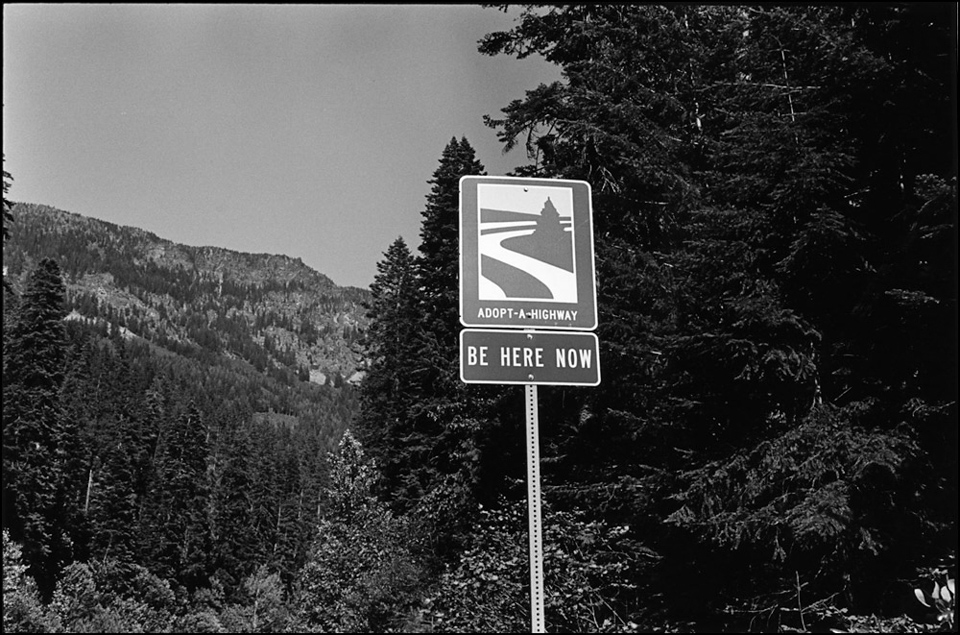
© Blake Andrews
I recently read the tongue-in-cheek blog you wrote about the perils of instagram and I was wondering what your personal relationship with social media was like? Recently, I’ve been struggling with what I am willing to share, should I share my best work, keep the best back for projects, share nothing at all? Does it even matter? Do you have a policy for what work you share online?
I am the last person you should ask advice on social media, because I’m not very good at it. I’m just bumbling my way along with no strategy or goal. Basically I’m a photographer, I’m fluent in photography, and social media is a good place to communicate in that language. So that’s where I share pictures, one a day for roughly the past 5 years. For a while they were on my blog, then Tumblr, now Instagram. I never know which photo to post, and it’s often surprising to see which ones cause which reactions. Gauging feedback is like reading tea leaves, almost a complete crapshoot. I don’t get it at all. Maybe that’s what keeps it entertaining.
Yeah, it’s weird. The photos I like best often get the least attention and the ones I like least get the most. I’m pretty much at the point now where I try not to pay any attention to that. I am starting to wonder though, about how much the of the role that instagram plays could be construed as the modern day photobook? Do you think there is any merit in carefully curating a photo series to display on the internet vs in a book?
Yes, some photographers are very good at catering series to the Instagram platform. I enjoy the ones which cut and paste photos specifically for the IG grid. The photos fall apart on their own. They’re tied to the platform, the same way photos in a book have a symbiotic relationship with the book form. That said, I think any material on a screen is still quite different than material in a physical book. It’s apples and oranges.
You’re a big photobook collector, right? So what do you think of self publishing work in books and zines?
I think it’s great. There are more opportunities to self publish than ever. But at the same time, there are probably decreased opportunities for mass distribution.
Are you someone that shoots with a project in mind, or do you prefer shoot everything and put things together later on? Why do you prefer to shoot that way?
I almost never make any particular photo with a project in mind. “Shoot first, ask questions later,” is my mantra. Both steps are necessary, and in that order. I sometimes divide my photos into projects for the sake of exhibitions or other outside curations, but it always feels like an artificial filter. It’s probably more accurate to think of all my photos as one huge life-long project. I’m just a walking, talking machine for photos. Point me in whatever direction and I’ll convert what’s in front of me into photos. That’s the project.
You’ve recently started posting these creepy garbled panoramic smartphone photos. How did you come up with that idea?
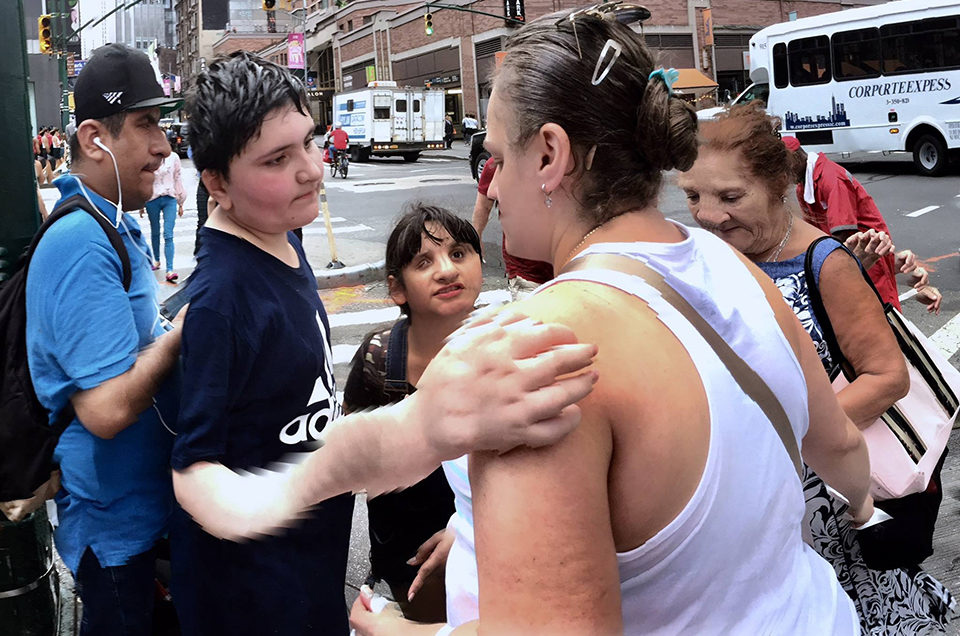
© Blake Andrews
Well it’s not my idea. There are many other people doing similar photos. My friend Bryan was probably the first person who showed me this style a few years back. And George and Gary, and on and on. So I was familiar with that method but it wasn’t until recently that I began tinkering with it more seriously. I was on an East Coast trip in many crowded situations, but my rangefinder was broken. So I began using my iPhone more than normal. The Panos seemed fun, and weird, and different. I love the bizarre glitches and the unpredictability. The “creepy” factor, in your words. So I played with them some on the streets of Boston and NY. But I didn’t really turn the corner until I decided to crop them down to conventional 35 mm aspect ratio. That seemed to dilute the Pano effect and thus make them a little more absurd, which for me is usually a step in the right direction.
I love them personally, but it has caused some controversy within your collective, In-Public, because the photo was not deemed to be real street photography. It’s obviously a matter of opinion, but what are your thoughts on what is and what isn’t street photography?
Honestly I don’t care what “real street photography” is or isn’t. I don’t like to be hemmed in by definitions or boundaries or rules. #CanPubPhoto? That’s a load of crap in my opinion. There is only one important measurement of a photo: Is it interesting or is it boring? Unfortunately most photos fall into the second camp, and it’s a constant struggle to make them interesting. But that’s my goal. All the other labels are useless.
So, this article on the phoblographer said that one of your panoramic photos being picked as photo of the month has lead to the founding member of the group to quit. Is that true?
Yes.
And what does this mean for In-Public right now?
There have been some tense interactions in recent weeks, but things have settled down now with the departure of Nick and Nils. I think the group will undergo some more changes in the immediate future, and in the longer term you’ll probably see us expand our vision a bit.
This is something I like to do with the photographers I interview, because it normally offers a good insight into the photographers mind. So, could you pick three favourite photos and talk about them?
It’s impossible to pick three favorites so I’m going to choose three recent photos which are fresh in my mind. These are all photos I’ve posted recently to Instagram.
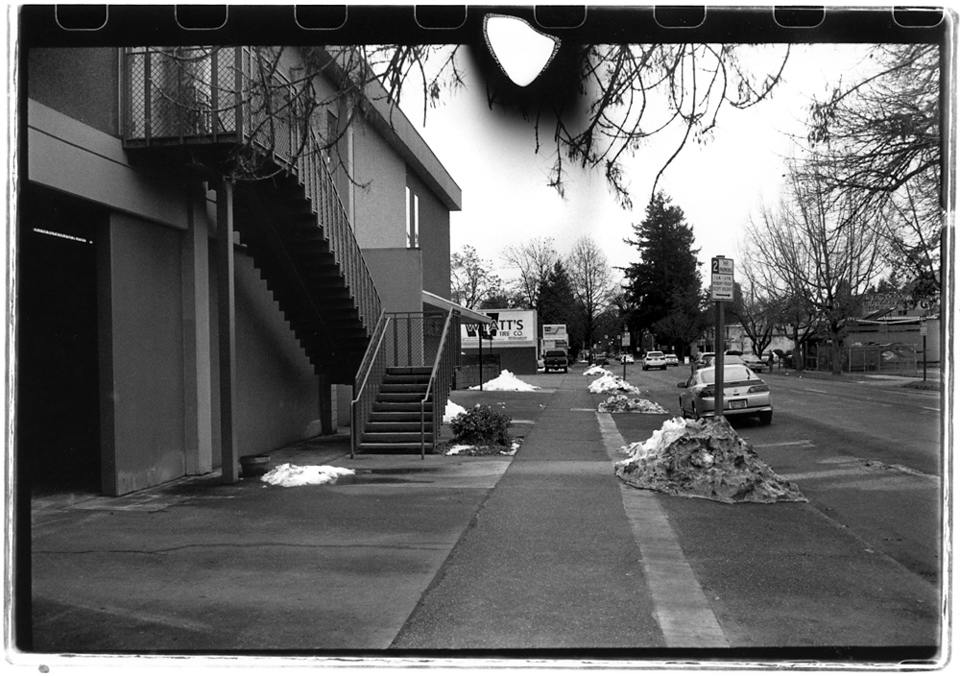
© Blake Andrews
Every so often I mess up loading film rolls. If the film doesn’t stay in its track and two parts touch, you’ll get blank spots where the developer can’t penetrate. There’s no controlling it. The location is random and usually ruins the frame. But in this case the blank spot landed in the most beautiful place! It forms a giant snowball in the upper part of the frame. Even better, the subject matter below is a sidewalk with piles of snow. Even if I were trying I could never again make a photo like that on purpose. It’s a gift from the photo gods. I’m sure that other people screw up their film rolls just like I do, but I don’t think many make prints from the errors. Most people wouldn’t look twice at that frame. They’d just chuck it. So to make a print of it feels special for me, like I’m claiming something that’s all mine. I printed it full frame in a wide carrier so that the sprocket holes would contain the damaged area.

© Blake Andrews
This photo I shot in June while visiting San Francisco. I’d been there a few days and was ready for a break from downtown. So I took the BART over to the Mission area to shoot there a little. On Valencia Street I noticed this young woman having her photo taken by a friend. It was a busy sidewalk so she kept being delayed as folks walked through the photo. Something about the scene attracted me so I hung around nearby. When the coast was clear this woman pulled up her skirt for a half second, and I was surprised to see she had nothing on underneath. So I guess that was the photo they wanted. I took it too. For me there’s something very direct about the image. I mean, any beautiful naked ass grabs you immediately. So there’s that. But it also has a deeper mystery, with the wording and the moment and the way all context has been stripped away. It’s hard to attach any easy narrative, or figure out the photographer’s (that’s me) relationship to the scene.
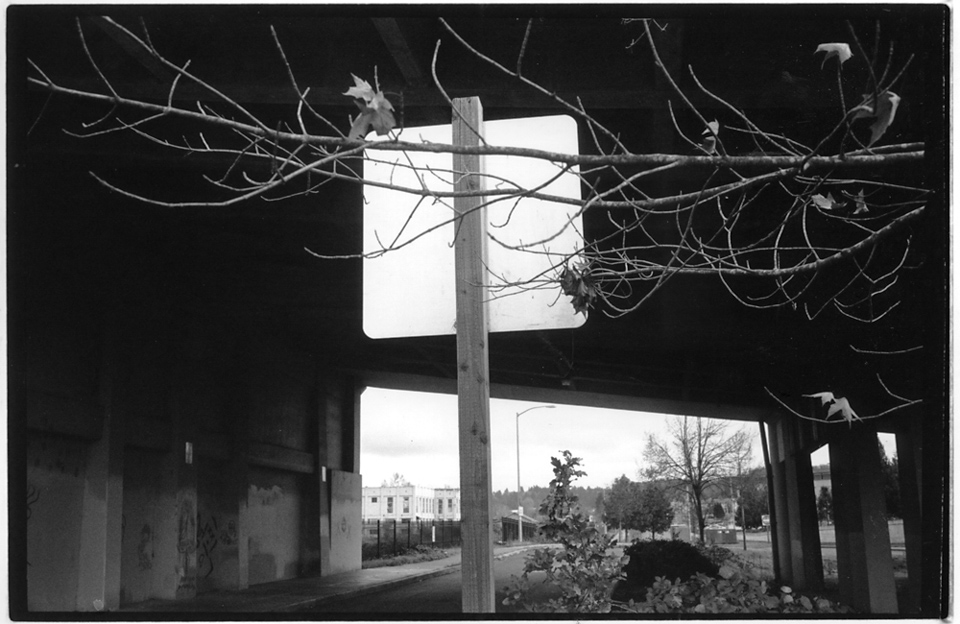
© Blake Andrews
This one I shot recently, but it’s typical of my formal layering style from about a decade ago. It’s the kind of photo that only works in monochrome, only from a specific vantage, and only at a certain time of year. In other words, the photo depends entirely on the maker, not on the scene. The background shows an overpass in Eugene. Over a decade I probably walked by this scene at least 50 times before I eventually saw the photo. I like the fact that it’s such a boring, dull place. Who could imagine a photo there? I’m quite sure no one else has made this photo, and no other photographer would see this photo even if you set them down exactly in my shoes. And yet there it is, a reminder that such opportunities surround us everywhere, every minute, in the least likely places, even some podunk college town in Oregon.
Where can people find your work?
No idea. Maybe start with Google?
What’s coming next from you?
A steady firehose of photographs, until I’m physically, financially, or mentally unable.
Thanks Blake!
For anyone interested in seeing more of Blake’s work, go check out his blog, the In-Public website, or his instagram: @swerdnaekalb.
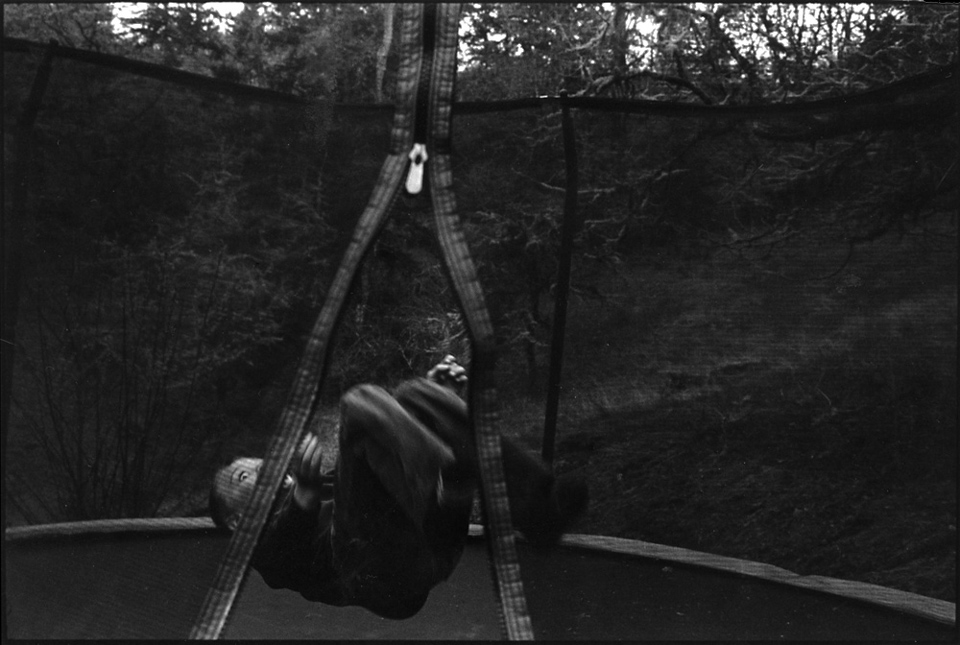
Pingback: Street21 – Streetfotografie in der Praxis neu definiert – Street Life international – fotoblog dokumentarfotografie